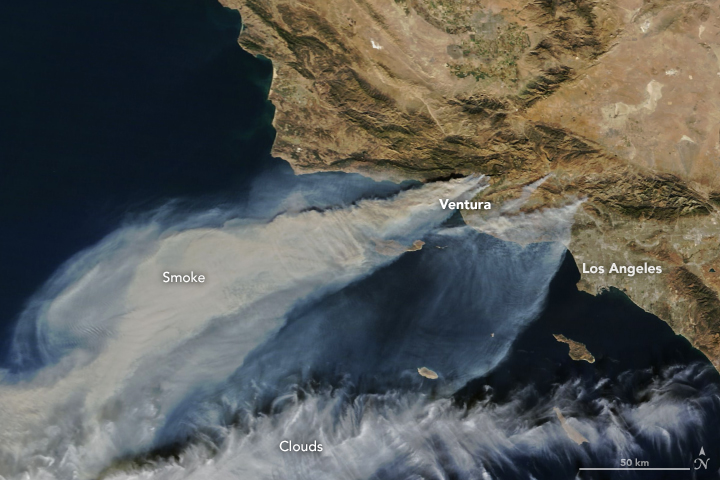1 February 2019
Climate change may push Santa Ana fire season into winter months
Posted by llester
By Liza Lester
Dry Santa Ana winds blowing downslope from the Great Basin through the mountains to the coast have historically fanned fires on the Southern California coast in fall, during the driest part of the year. Although the winds peak in winter, rain helps to wet vegetation and douse fire vulnerability.

Santa Ana winds blew smoke from the fast-moving Thomas, Creek and Rye fires over the Pacific on 5 December 2017. Wind gusts topped 112 kilometers (70 miles) per hour that week. An extended span of dry weather left the ground parched well into Southern California’s “wet” season, which starts in October.
Credit: NASA Earth Observatory
Now, new climate modeling published in AGU’s journal Geophysical Research Letters predicts the warm, dry Santa Ana winds will be less frequent, and to some extent less intense, during the 21st century. The change is predicted to be greatest in spring and fall, with winds remaining strong during the peak season in December and January.
A pressure difference between the inland Great Basin and the Pacific Ocean drives the Santa Ana winds. This difference is predicted to diminish as the climate grows warmer. The Santa Ana season, currently from September through May, will effectively shrink, according to the new study.
Independent studies have predicted a parallel decrease in rain during spring and fall, leaving vegetation dry until winter. This combination of changes in the Santa Ana winds and rain may push Southern California’s coastal fire season from fall into the early winter months, according to the new study.
With less frequent autumn winds, fire risk is predicted to decrease during October and November under predicted climate warming, but dry fuels will remain on the ground when the worst of the winds arrive in December. Southern California’s fire future may look more like 2017, according to the authors of the new study, when the Thomas Fire and several other fires ignited in December. The Thomas Fire burned 281,893 acres of Ventura and Santa Barbara Counties.
— Liza Lester is a public information specialist and writer at AGU. Follow her on twitter @lizalester.










 GeoSpace is a blog on Earth and space science, managed by AGU’s Public Information staff. The blog features posts by AGU writers and guest contributors on all sorts of relevant science topics, but with a focus on new research and geo and space sciences-related stories that are currently in the news.
GeoSpace is a blog on Earth and space science, managed by AGU’s Public Information staff. The blog features posts by AGU writers and guest contributors on all sorts of relevant science topics, but with a focus on new research and geo and space sciences-related stories that are currently in the news.